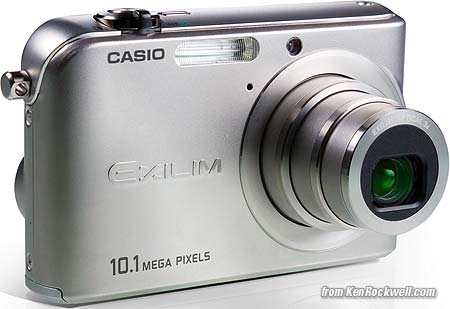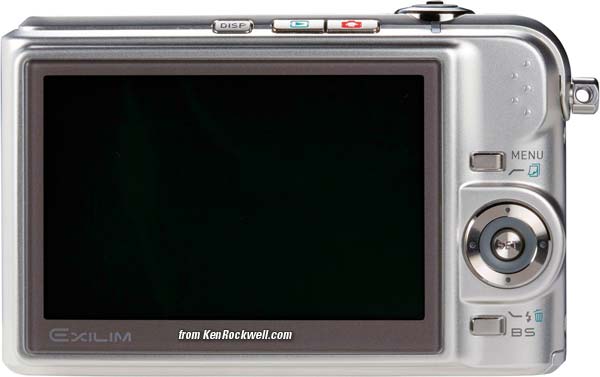Home Search Gallery How-To Books Links Workshops About Contact
Casio
EX-Z1000 Summary: Best image quality yet, but clumsier than other Casios. I prefer the EX-Z850 which is much easier to use. When I want more quality I take an SLR. I use these cameras for convenience. The small quality improvement isn't worth the hassle for me, so I prefer the similarly priced EX-Z850. INTRODUCTION Casio announced this on April 26th, 2006. I got hold of one on July 17th, 2006. Casio never stops. I just bought my new EX-Z850 a few weeks before. The EX-Z1000 sells for around $399 in August 2006. The EX-Z1000 is a tiny 10 Megapixel pocket camera with a giant 2.8" screen, bright enough to be seen easily in direct sunlight. I prefer the EX-Z850 for serious shooting or the EX-S600 for size. This EX-Z1000 lacks some of the controls I prefer of the EX-Z850, and lacks some of the ease of use of either of the other two. The EX-Z1000 has marginally better image quality than the other models, but not enough to make up for the lack of convenience Most of the Casios are similar in operation, which is excellent. I go into the most excruciating detail about how to operate them in my EX-Z750 review. All that applies to the EX-Z1000. SPECIFICATIONS Resolution: 10 MP: 3,648 x 2,736, 3,648 x 2,432 (3:2), 3,648 x 2,048 (16:9), 2,560 x 1,920, 2,048 x 1,536, 1,600 x 1,200 and 640 x 480 pixel image sizes. Movies in 640 x 480 and 320 x 240, 25 or 12.5 FPS. Lens: F/2.8 to 5.4, 7.9 to 23.7 mm, f/2.8 - 5.4. 7 elements in 5 groups. One aspherical element. Similar to 38 to 114 mm on a 35mm film camera. It's sharp, and seems like the same lens used on most of the other Casios. CCD: Larger 1/1.8" size. ISO: 50, 100, 200 and 400. Up to ISO 3,200 in a trick mode. LCD: Huge 2.8" screen, 230,400 pixels. Blinding 1,200 cd/m^2 rating for great visibility in direct sunlight. Displays up to 12 images at once. Menus also shown along right side. It's much wider than tall, so normal images will not fill the entire width without being cut off on top and bottom.
Casio EX-Z1000. Note wider screen. Normal images won't fill it from side to side. Battery: NP-40, CIPA rated at 360 shots, with the LCD turned down to normal. I usually get a lot more than this on my other Casios, even with the screen set to bright. I use the flash infrequently, the CIPA rating is using flash 50% of the time. Accessories Included: Charging/Download cradle and AC adapter, Battery, USB and AV cables, strap, software on CD. Colors: Silver or Black. Here it is in black: Size: I measure 3.822" W x 2.363" H x 0.889" D (97.11 x 59.90 x 22.63 mm), including projections with the lens collapsed. Casio specs 3.62” (W) x 2.30” (H) x .88” (D) excluding projections, 0.78” at thinnest part. Weight: I measured 6.000 oz (170.1g) with battery, memory card and strap. Casio specs 4.9 oz. naked (no battery, no card, no strap.) PERFORMANCE OVERALL Image quality for still shots is the best from any Casio I've used. Movie quality is awful. I prefer other Casios I've used, like the EX-Z750, EX-Z850 and EX-S600, because they are easier, more convenient and faster to use. The image quality improvement in the EX-Z1000 is minor. All the Casios can make great enlargements. Color rendition is similar to other Casios. I've never been a fan of Casio's color rendition. I prefer the colors of Canon compact cameras, but the Canons have never handled fast enough for me. That's why I own the Casios. I think their color rendition issues may be from oversensitivity to infra-red. I was experimenting and discovered dark, tungsten-backlit LCDs looked too light when photographed with the EX-Z1000. I want to get my hands on an infrared-cut filter. The lens appears identical to the one on the EX-Z750 and EX-Z850. The EX-Z850 has a lot more default sharpening than the EX-Z1000. The EX-Z850 looks harsh and nasty compared to the EX-Z1000 at 100% on my monitor. The EX-Z1000 looks much better and more natural. Turning the sharpness of the EX-Z850 down to -1 gives a much better result. POWER The NP-40 battery took 2.5 hours to charge from the cradle. It's the same battery as many of the Casio cameras. I long gave up trying to run down the battery in a day. Battery life is longer than I can dish out, presuming you drop it in the cradle to charge each night. SHOOTING Handling The menu adjustments are always shown on the right of the screen. This is an advantage of the wider screen. Trick: tapping the SET button calls up the last menu used, while tapping the DOWN button starts from the top. This give you instant access to two menus. You can set the left/right keys to another function, like WB or exposure compensation, to give easier access than on my Nikon D200 SLR! LCD The very bright screen means it works great in direct sun. Gone are the days of having to shield the camera in daylight. I wish my Nikons could do this! There is no optical finder. The 2.8" LCD is extra-wide. This is weird, since it's a different shape than photos. The good news is the extra wide screen puts all the shooting data on the left, and you can get to adjustments instantly by pressing the SET button and scooting around them as menus. You also can tap the controller DOWN and call the settings from the top down. It's easier to do than to reading about it. It's EASY! The bad news about the extra-wide screen is that the image is on the left five-sixths of the screen, while the data is on it's own gray bar on the rightmost one-sixth. This is weird. It makes composition disturbing, since the center of the screen isn't the center of the image. I'm tempted to compose as if the gray bar is covering some active image. It's not: it's separate. I prefer the smaller, but correctly shaped, LCD of other models. Exposure Modes Program and preset scenes. The preset scenes are called BS (Best Shot) modes. God bless the Japanese for these acronyms. You may use those programmed in the camera, or save as many as you like, up to about one-thousand different modes! No Manual, A or S exposure modes. Not a big deal; just makes it more confusing to find long exposures in the BS modes (canned scene presets). The longest exposure is 4 seconds in the night scene BS mode. High ISOs ISO only goes to ISO 400 in regular modes. Like most compact cameras, it looks great at ISO 50 and almost as good at ISO 100. ISO 200 looks a little rough, and ISO 400 is grainy. It can go as high as ISO 3,200 in a trick scene mode. It looks very, very soft, since the camera tries to filter out all the grain. it works great; just don't expect super sharp results poster size. Anti Shake Anti-shake mode is not active image stabilization like Nikon's VR or Canon's IS. Casio's anti-shake is simple passive use of faster shutter speeds and ISOs. Manual White Balance Manual White Balance has a huge range. It's better than most Casio and other cameras. It's good enough enough to allow normal colors when photographing under orange high-pressure sodium street lights! Continuous Advance (Shooting or Shutter) Mode The normal speed continuous mode works fine, but it sometimes can get slower than my other Casios. The high speed modes are trick modes that result in softer images. The gotcha for me on shooting is that I always use the CONTINUOUS mode. In dim light I hold the shutter to make a few shots. I pick out the sharpest one at home. If I don't hold the shutter it only makes one shot. If I hold it, I get more. The CONTINUOUS mode is my setting on every camera I own. On the EX-Z850 I can set this mode in one press of the EX button and one press down of the nav button. The EX-Z1000 hides this in a menu: MENU: REC: (two clicks to get to) CONTINUOUS: (two clicks to get to) NORMAL SPEED: SET. That's about six clicks versus two. That's a pain to do every time I shoot, and a reason I prefer the other cameras. Audio Mic on front. Speaker on bottom. Press the DISP button when recording audio to turn off the LCD and allow battery life of about a day of continuous recording. Movies If video is important to you I'd suggest a different camera. By comparison to the Z750, Z850 or S600, the video of the EX-Z1000 is awful. It's dull, desaturated, fuzzy and has bad vertical smearing, even between areas of little difference in brightness. The video file size for a "normal" quality movie from the EX-Z1000 is almost three times the file size from the other cameras, while the quality is much worse. This means you can record only about a third as much video on a card, and it looks awful compared to the other cameras. It's much sharper in HQ mode, but the file sizes in normal mode are already three times the size as the other cameras' files. It's much sharper, but with half the resolution, in LP mode. I have a sneaking suspicion that the normal mode is really a blow up from 320 x 240. The EX-Z1000 can't play files from the Z850 or S600. Either of those cameras easily plays files from the EX-Z1000. The huge files sizes are because Casio opted to regress to a less efficient but more universally legible video format in the EX-Z1000. The other cameras use an advanced MPEG-4 coding scheme that requires special software to decode, but looks great with small file sizes. The EX-Z1000 uses motion JPEG which is easy to play, but looks awful for the same file size. Motion JPEG throws together a bunch of still JPGS, but makes no use of motion vectors or P or B frames to reduce file size. It uses only I frames. |
These are still frames grabbed from video on three cameras. Notice the purple smears running down into the bushes from the white parts of the house. This is severe vertical blooming. It's even more annoying with bright points of light. They will cause bright purple lines to run vertically across the image. All clips were made at "Normal" and were 10 seconds long. The EX-S600 and EX-Z850 files were 2.7MB and the EX-Z1000 was 7.7MB. |
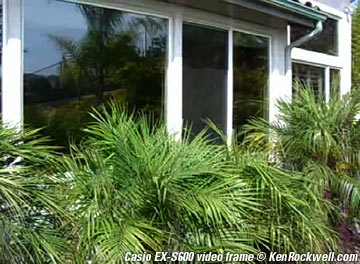 |
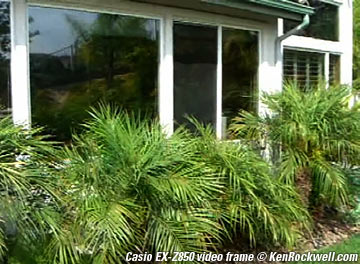 |
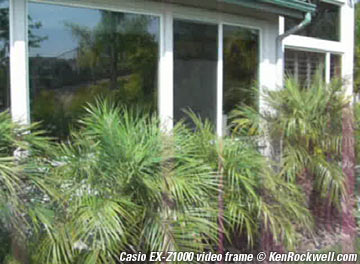 |
CRASHES I had the EX-Z1000 dies on me once while shooting. It turned off and didn't respond, with the lens out. It was as if the battery was dead, but it wasn't. I tried taking the battery out and in. That didn't work. I tried another battery fresh off the charger and that didn't work. Each time it would blink its green light once for a tenth of a second to let me know it knew the battery was in, but continued to play dead. What did work was putting it on its cradle. It turned back on and pulled its lens back in. I turned it off, took it off the cradle, and it was fine again. PLAYBACK Bad news is that on playback you no longer can tap the DISPLAY button to toggle the data on/off. You have to press the DISPLAY button and run through menus. I hate this! This is another reason I prefer the other Casio cameras. The screen of the EX-Z1000 is much wider than the photos. On playback there are black bars on each side, or you can choose to zoom the image slightly to fit from left to right, except it chops off the top and bottom. I would complain, except that even with black sides the bigger screen gives the same size image as other cameras with 2.5" screens. This isn't as weird as when shooting, since the playback image is centered. LCD viewing angle is normal. It looks lighter from above and darker from below. LCD color rendition is about the same as the other Casios. I find the screen on my EX-Z850 is sharper when looking at the same images held next to the EX-Z1000. DATA TRANSFER FROM CRADLE Data transfer is slow, only about 25 MB/minute. I would avoid this camera for this reason alone. Most other Casios are faster. It uses USB 2.0 "Full Speed." That's a euphemism for the old USB 1.1 rate of 12 Mb/s. The whole point of USB 2.0 is to run at "High Speed," or 480 Mb/s. The EX-Z750, EX-Z850 and EX-S600 are much faster since they run at the real USB 2.0 High Speed rate. It takes 5 minutes to download 125MB from the EX-Z1000. I popped the same card into an EX-S600 and my EX-Z850. It downloaded the same data, shot on the EX-Z1000, in 42 seconds. RECOMMENDATIONS The first thing you need to do when you get any Japanese camera is to turn off the stupid sounds. You do this in the menus. It won't bother you again with the cute beeps that amuse Japanese preschoolers. If you don't turn these off the EX-Z1000 has quite a vocabulary of sounds. If all you shoot are test charts than the EX-Z1000 is the best yet from Casio. I prefer convenience; the whole point of a compact camera, and for that I prefer the EX-Z850. Resolution isn't important. 8 MP is the same as 10 MP as you can read at The Megapixel Myth. I'm bugged by the slow data transfer, awful video, clumsier menus, weird screen shape and inability to turn the playback data on and off easily compared to the other Casios. No problem; Casio makes so many cameras there's one for everyone. |



